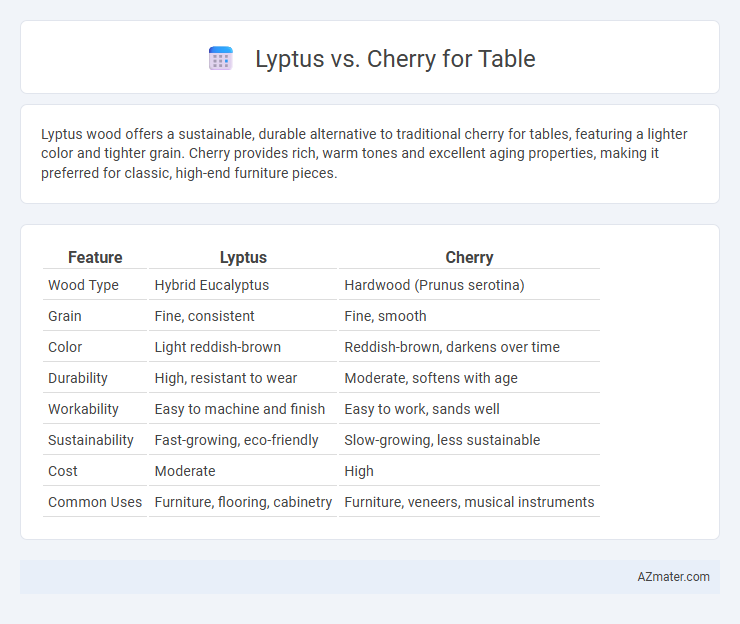Lyptus wood offers a sustainable, durable alternative to traditional cherry for tables, featuring a lighter color and tighter grain. Cherry provides rich, warm tones and excellent aging properties, making it preferred for classic, high-end furniture pieces.
Table of Comparison
| Feature | Lyptus | Cherry |
|---|---|---|
| Wood Type | Hybrid Eucalyptus | Hardwood (Prunus serotina) |
| Grain | Fine, consistent | Fine, smooth |
| Color | Light reddish-brown | Reddish-brown, darkens over time |
| Durability | High, resistant to wear | Moderate, softens with age |
| Workability | Easy to machine and finish | Easy to work, sands well |
| Sustainability | Fast-growing, eco-friendly | Slow-growing, less sustainable |
| Cost | Moderate | High |
| Common Uses | Furniture, flooring, cabinetry | Furniture, veneers, musical instruments |
Overview: Lyptus vs Cherry Wood for Tables
Lyptus wood, a hybrid Eucalyptus species, offers strong durability and resistance to warping, with a fine, uniform grain ideal for table surfaces requiring stability and a modern aesthetic. Cherry wood, valued for its rich, warm reddish-brown color that deepens with age, provides excellent strength and a smooth texture, making it a classic choice for elegant and traditional table designs. Both woods are sustainable options, but Lyptus matures faster, making it more cost-effective for large-scale use while Cherry commands a higher price due to its natural aging appeal and historic prestige.
Wood Characteristics and Appearance
Lyptus wood offers a dense, fine-grained texture with a consistent reddish hue that enhances its durability and resistance to wear, making it ideal for high-use tables. Cherry wood features a smooth, closed grain and rich, warm reddish-brown tones that deepen over time, providing an elegant, classic appearance. Both woods are stable and easy to work with, but Lyptus tends to have a more uniform color, while Cherry develops unique patinas and character marks with age.
Durability and Strength Comparison
Lyptus wood offers exceptional hardness and resistance to wear, making it highly durable for table surfaces subjected to frequent use. Cherry wood, while also strong, is slightly softer and more prone to dents and scratches over time compared to Lyptus. The superior density and hardness of Lyptus contribute to its enhanced strength, making it a more resilient choice for long-lasting tables.
Workability and Ease of Crafting
Lyptus wood offers excellent workability with its fine, uniform grain, making it easy to cut, shape, and sand for table crafting. Cherry wood, renowned for its smooth texture and moderate hardness, allows for precise detailing and seamless finishing, enhancing overall ease of crafting. Both woods respond well to hand and machine tools, but Lyptus tends to stay sharper longer and resists warping, providing a slight advantage in durability during the crafting process.
Sustainability and Environmental Impact
Lyptus wood is highly sustainable due to its rapid growth rate, typically harvested within 15 years from managed eucalyptus plantations, minimizing deforestation and habitat disruption. Cherry wood, often sourced from older hardwood forests with slower growth cycles, has a significantly larger environmental footprint and longer replenishment time. The controlled cultivation of Lyptus reduces carbon emissions and soil erosion compared to traditional cherry harvesting methods, making it a more eco-friendly choice for table production.
Cost and Availability Factors
Lyptus offers a cost advantage over cherry wood as it is a fast-growing hybrid eucalyptus, making it more affordable and sustainable for table production. Cherry wood, sourced from slower-growing hardwood trees, commands higher prices due to limited availability and longer maturation periods. The widespread cultivation of Lyptus in managed plantations ensures consistent supply, whereas cherry availability fluctuates with regional harvest cycles and demand.
Maintenance and Long-Term Care
Lyptus requires minimal maintenance due to its high resistance to moisture and scratches, making it ideal for busy environments. Cherry wood demands regular conditioning and protection from direct sunlight to prevent fading and maintain its rich color over time. Long-term care for Lyptus is simpler, as it remains durable without frequent refinishing, whereas Cherry benefits from periodic polishing to preserve its natural luster.
Popular Table Designs with Lyptus and Cherry
Lyptus and cherry wood are favored choices for popular table designs due to their durability and aesthetic appeal. Lyptus offers a fine, uniform grain and a warm reddish-brown tone, making it ideal for contemporary and minimalist table styles. Cherry wood, renowned for its rich color that deepens over time and smooth texture, is often selected for classic, traditional tables, contributing elegance and timeless charm to living spaces.
Consumer Preferences and Trends
Lyptus offers a sustainable alternative to cherry wood, favored by environmentally conscious consumers for its rapid growth and durability, while cherry remains prized for its rich, warm tones and classic appeal. Market trends indicate a rising preference for Lyptus in modern, eco-friendly furniture lines, where consumers seek both aesthetics and sustainability. Consumer reviews emphasize Lyptus's resistance to scratches and affordable pricing, contrasting with cherry's traditional luxury status and natural aging pattern, which deepens its color over time.
Final Verdict: Which Wood is Right for Your Table?
Lyptus offers a sustainable alternative to traditional hardwoods, featuring a dense, uniform grain that resists wear and scratches, making it ideal for everyday use in tables. Cherry wood provides a timeless, rich reddish-brown color that deepens beautifully with age and is favored for its workability and classic appeal in fine furniture. Choose Lyptus for durability and eco-friendliness, while Cherry suits those seeking elegance and a warm, vintage aesthetic for their table.

Infographic: Lyptus vs Cherry for Table
 azmater.com
azmater.com